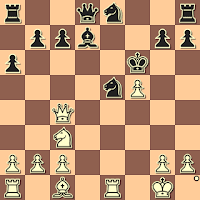Last year I received a game with an unusual defense to the Italian Game. I thought, at the time, that it had to be a one-off, but I discovered a handful of similar games in The Database, and another dozen or so related ones online.
I thought I would share some games, not because the defense is strong - or, as it turns out, something that stops a Jerome-ish reaction - but because it could be a distraction that could eat up thinking time in a blitz game.
JackChessplayer - NN
3 0 blitz, lichess.org, 2020
1.e4 e5 2.Nf3 Nc6 3.Bc4 b5
Here we go. I have not found a name for this line. It seems dubious - if a Jerome Gambit player can call any line "dubious".I am not sure what the idea is, after the logical 4.Bxb5. I have seen continuations such as 4...a6, leading to an odd-style main line Ruy Lopez, and 4...Nd4, leading to an unusual Bird variation of the Ruy Lopez.
In any event, Readers can guess the response by White that I am interested in.
4.Bxf7+
Meeting a surprise move with a surprise move. Black does not have a vulnerable Bishop sitting at c5, but White's Queen can still add pressure.
4...Kxf7 5.Nxe5+
The Knight sacrifice is thematic and probably strongest, but also seen has been5.d4 d5 (5...exd4 6.e5 Ba6 7.Ng5+ Ke8 8.Ne4 b4 9.Qh5+ g6 10.Qf3 d5 11.Ng5 Nh6 12.e6 Be7 [12...d3] 13.Nf7 Nxf7 [13...Ne5] 14.Qxf7 checkmate, Oldfishbones - Grojzek, FICS, 2006) 6.dxe5 dxe4 7.Ng5+ Ke8 8.Qh5+ g6 9.Qe2 Nxe5 [9...Nd4] 10.Qxe4 Qd6 11.Qxa8 Be7 12.Qxc8+ Bd8 13.O-O Ne7 14.Nc3 Rf8 15.Nce4 Ng4 16.Nxd6+ Black resigned, yorgos -Docdhc, FICS, 2008; and
5.d3 Nd4 (5...h6 6.Nc3 Nd4 7.Nxd4 exd4 8.Nxb5 d5 9.Qf3+ Nf6 10.exd5 [10.e5] 10...Qe8+ 11.Kd2 Qxb5 12.d6 Bxd6 13.Qxa8 Qg5+ 14.Kd1 Bg4+ 15.f3 Rxa8 16.Bxg5 hxg5 17.fxg4 Nxg4 18.Rf1+ Kg6 19.h3 Nh2 20.Re1 Rf8 21.Kd2 Rf2+ 22.Re2 Bf4+ 23.Kd1 Rf1+ 24.Re1 Rxe1+ 25.Kxe1 Bg3+ 26.Ke2 c5 27.Rf1 Nxf1 28.Kxf1 Kh5 29.Ke2 g6 30.Kf3 Be5 31.Ke4 Bh2 32.Kd5 g4 33.hxg4+ Kxg4 34.Kxc5 g5 35.Kxd4 Kf4 36.c4 g4 37.c5 Kg3 38.c6 Kxg2 39.c7 Bxc7 40.Kc4 g3 41.d4 Kf2 42.d5 g2 43.Kc5 g1=Q 44.Kc6 Bf4 45.d6 Qc1+ 46.Kd5 Qd2+ White resigned, alipio - makkarakolme, FICS, 2008; 5...Be7 6.d4 d6 7.dxe5 dxe5 8.Qxd8 Nxd8 9.O-O Nf6 10.Nxe5+ Ke6 11.f4 g5 12.Nc3 gxf4 13.Bxf4 Bd6 14.Nd3 Nf7 15.Bxd6 [15.e5] 15...Rd8 16.Bxc7 Rd7 17.Bg3 Bb7 18.Nf4+ Ke7 19.e5 Nxe5 20.Rfe1 Nfg4 21.Nh5 Rf8 22.Bxe5 Nxe5 23.Rxe5+ Kd8 24.Rd1 Rxd1+ 25.Nxd1 Re8 26.Rxe8+ Kxe8 27.Ne3 Bc6 28.g4 Bd7 29.h3 Kf7 30.Nf5 Ke8 31.a3 Bxf5 32.gxf5 a6 33.Kg2 h6 34.Kg3 Kd8 White lost on time in a winning position, BurtForFun - pscarpi, FICS, 2008) 6.Ng5+ Qxg5 $2 7.Bxg5 h6 8.Be3 Ne6 9.Qf3+ Ke7 10.O-O Ng5 11.Qg3 Ke8 12.Qxe5+ Be7 13.Qxg7 Nf7 14.Nc3 Bf8 15.Qd4 c5 16.Qd5 Nf6 17.Qxa8 Nd6 18.e5 Ke7 19.exd6+ Kxd6 20.Nxb5+ Ke7 21.Bxc5+Ke8 22.Qxc8+ Kf7 23.Bxf8 Rxf8 24.Qc4+ Ke8 25.Nd6+ Kd8 26.Qc8+ Ke7 27.Rfe1+ Kxd6 28.Qxf8+ Kc6 29.Qxf6+ Black resigned, qhdo - EBARE, FICS, 2008.
5...Nxe5
Recently Black tried 5...Ke8 but the game ended quickly 6.Qh5+ g6 7.Nxg6 hxg6 8.Qxg6+ Ke7 9.Qf5 Qe8 10.d3 Nh6 11.Bg5+ Kd6 12.Qd5 checkmate, Ramadan_seagull - eyezacker, Chess.com, 2021)
6.Qh5+ g6
Instead, 6...Ng6 allows White to win the other Rook, but he still has to be careful 7.Qd5+Ke8 8.Qxa8 Bc5 9.Qd5 [9.0-0] d6 10.Nc3 [10.Qb3] Nf4 White resigned, exatico - VietLion, FICS, 2006.
7.Qxe5 Qe8 8.Qxh8 Black resigned
White admitted that he did not know why his opponent resigned here, and I have to agree with him: despite the lost Rook (he is down the exchange for two pawns), Black has a won game after 8...Qxe4+.So, does that mean that 3...b5 is viable against 4.Bxf7+ ? Well, no. For starters, White went after the wrong Rook on move 8. He should have played 8.Qd5+ and then 9.Qxa8, with advantage.
If Black were to play 7...Nf6, White would have 8.Qxb5. The computers would still like Black, but White would have 3 pawns for his sacrificed piece, instead of the usual 2 pawns.
Likewise, White probably should answer 7...d6 with 8.Qxb5, as 8.Qxh8 would be risky as the Queen could be trapped and won, e.g. 8...Nf6 9.d3 Qe7 10.Nc3 Bb7 11.Bg5 Bg7 12.Qxh7 Rh8 13.Qxh8 Bxh8.





























GM Smerdon,
I am working my way through your fascinating The Complete Chess Swindler, a topic that greatly appeals to me, from both a psychological perspective and as a matter of survival: I have been researching and playing the worst chess opening ever, the Jerome Gambit (1.e4 e5 2.Nf3 Nc6 3.Bc4 Bc5 4.Bxf7+), for a couple of decades, and have come to realize that any success whatsoever has been due to swindles. (I immediately apologize to the ghost of Frank Marshall and other masters, living and dead.)
Many thanks for your hard work.
Hi Rick. I recently came across the Jerome Gambit on YouTube. It’s….quite something!